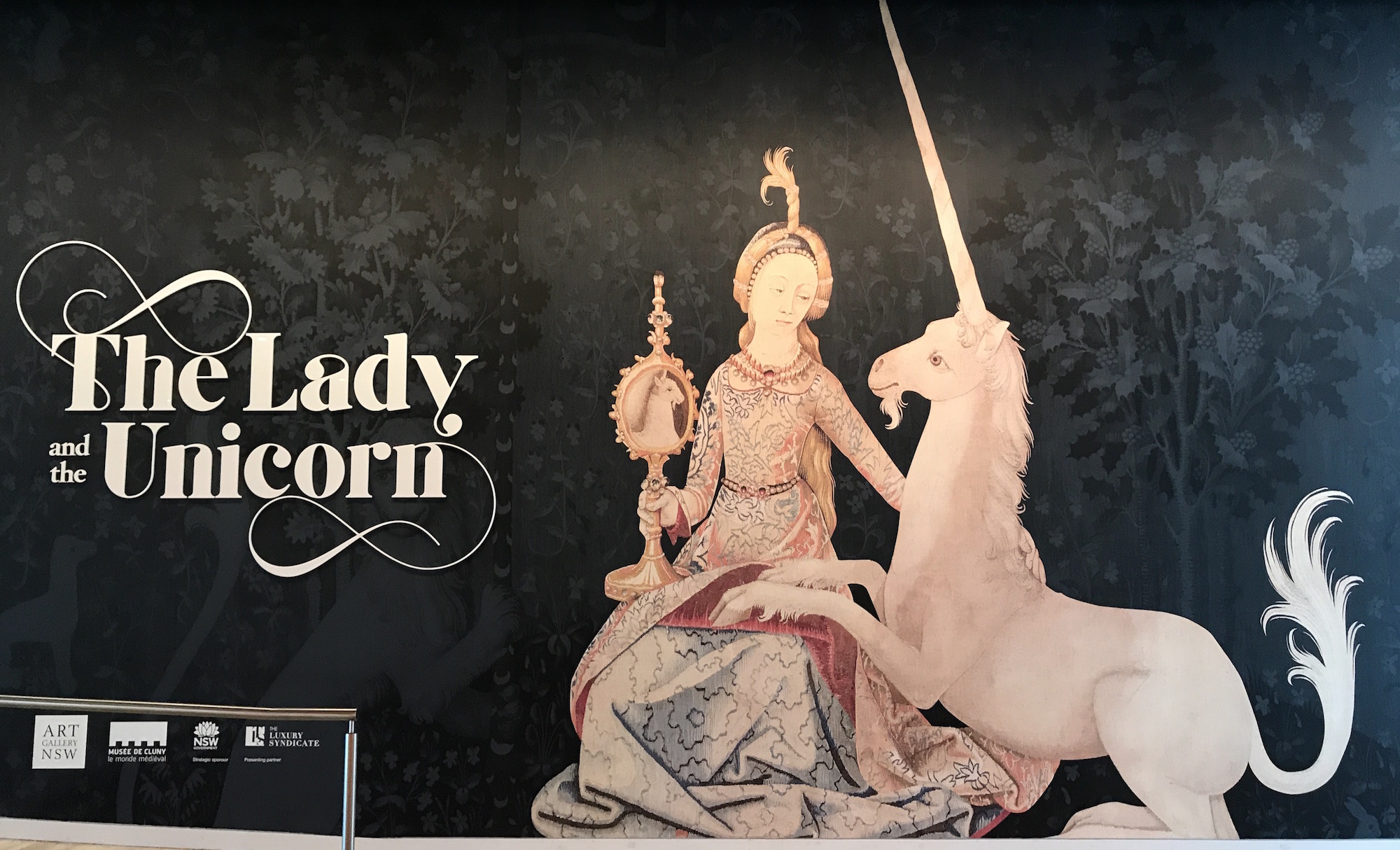One of the rarest medieval French Tapestry masterworks in history, “The Lady And The Unicorn” is currently on display at the Art Gallery of New South Wales, marking the third time in history these tapestries have left France in over 500 years.
Created around c1500 and simply referred to as “”The Lady And The Unicorn”, these six tapestries represent the five senses touch, taste, smell, hearing and sight. Little is known about the origins of these masterworks, not even their creator, only that they were eventually discovered hanging in the Château de Boussac, a small castle in central France, and it was writer and then Inspector General of Historic Monuments, Prosper Mérimée, that recognised the cultural significance of the tapestries, and expressed concern over their condition, submitting that they be purchased by the state to ensure their survival. by the 1800’s, tapestries were often in very poor condition, thanks in no small part to Mérimée, “The Lady And The Unicorn” has not only survived but has done so in excellent condition, a further testament to his keen eye for quality.
Often been referred to as “The Mona Lisa of the Middle Ages”, The Lady And The Unicorn is graciously on loan from the Musée de Cluny – Musée national du Moyen age and will be on display at the Art Gallery Of NSW, in Sydney Australia. for the first time in its 500 year history, and is now on display till the 24th June 2018.
“A French National Treasure, Referred to as The Mona Lisa Of The Middle Ages!”

Of all the tapestries, this one holds the most amount of intrigue, what many believe the five other pieces to represent being the five senses, the inclusion of this piece is somewhat of a mystery. Thought to represent the sixth sense, which during medieval times often meant the soul, the mind of the heart, further alluding to a religious theme in correlation to the present of the unicorn (representing Christ).
Related: A Once In a Lifetime Event Featuring Pieter Bruegel The Elder
Background & History
Designed in Paris about 1500, the tapestries are considered to be some of the greatest surviving masterpieces of medieval European art. They depict a lady flanked by a lion and a unicorn, surrounded by an enchanting world of animals, trees and flowers. One of the most intriguing aspects of these six large-scale artworks is the mystery of their origin and meaning. Further more, whom were these masterpieces made for and what was there originally intended symbology? – From The Exhibit brochure.
Often interpreted as a vivid meditation on earthly pleasures and courtly love, the tapestries showcase the sublime skill of medieval artisans. They can also be viewed as an allegory of the five senses – sight, hearing, taste, touch and smell – as well as a sixth sense – heart or will – represented by the phrase ‘mon seul désir’ or ‘my sole desire’.
While the millefleur (‘thousand flower’) backgrounds was a popular style in the late middle ages for these such works, the choice of red as the dominant colour is rare. A common theme among late medieval era tapestries and art in general for that matter, was of religious influence, in these works, the Unicorn represents purity and chastity, and could also be seen to represent Christ’s incarnation. The unicorn, lion are shown bearing the Le Viste coat of arms, which, one would assume were the family who commissioned the tapestries.
The Exhibit
Presented in a dark room surrounded by towering black walls, one finds themselves truely in awe from the imagery of these tapestries. The stark contrast of red against the black backdrop further ensures an immersive visual experience, leaving the viewer calm and relaxed. exerts of “The Notebook of the Malte Laurids Bridge” by Rainer Maria Rilke, are carefully peppered along the walls, complimenting the tapestries in such a way as to provide the viewer with an unofficial backstory.
Related: Social Commentary Meets Vintage Novel Covers
In a seperate room, is a television and various seating for visitors to learn more about the history of the tapestries, and provided with a deconstruction of the imagery and symbolism of these masterpieces. Plasted along the various walls are short essays providing further information regarding the tapestries Maker, the patrons (in this case, the Le Viste family), the commissioning process and creation, as well as a brief explanation of the bestiary themes within Medieval art.
“… there are six tapestries; come, let us pass slowly in front of them. But first of all take a step back and look at them, al together. Are they not tranquil?“
– “The Notebook of the Malte Laurids Bridge” by Rainer Maria Rilke
Accompanying these tapestries at the exhibit are various forms of media, including film and digital.





Unravel The Mystery
In Conversation With The Director Of The Musée de Cluny
On the opening day of ‘The lady And The Unicorn”, Art Gallery of NSW curator Jackie Dunn was in conversation with the general curator of heritage and Director of the Musée de Cluny, Elisabeth Taburet-Delahaye. Together they discussed the significance of these unique medieval tapestries, their mysterious origins, meanings and enduring appeal. (From Art Gallery of NSW’s Youtube)
*Images Courtesy of Musée de Cluny, all rights belong to them.
Exhibition Dates: 10 Feb – 24 Jun 2018
Tickets
#theladyandtheunicorn
Instagram, Youtube





